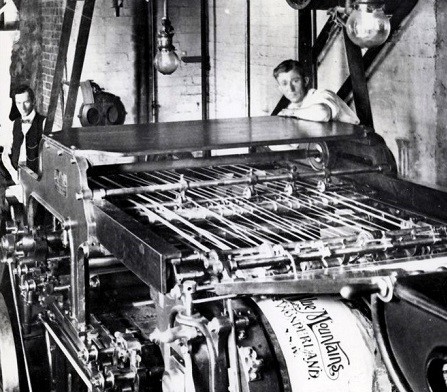
Before Black History Month is over, I am sharing a story about a Black man with a visual impairment. He was a poet, journalist and newspaper publisher. I learned about his life from the Blind History Lady and was compelled to share it here on my blog. As a Black blind journalist myself, it is not everyday I come across an intriguing story like this one. So, here goes.
Early Life and Education

James Edward McCall was born in 1880 in Alabama. He was the child of former slaves. As a young child, James had what they called “weak eyes” but the diagnosis and cause were unclear. To help compensate his mother would read to him. She was a seamstress and his father a cook. They deeply believed in education and James capabilities and sent him to school. In 1900, he graduated from Lincoln Normal School for Colored Students and proceeded to Howard University Medical School in Washington DC. During his first year, he contracted typhoid fever and lost the rest of his sight. Consequently he was unable to complete his education there.

James, now totally blind, didn’t stop pursuing an education. After he accepted his blindness, he went to Albion College in Albion, Michigan.; graduating in 1907. He was able to accomplish his goal by hiring other students to read class work. He had an interest in journalism and took all the required courses plus taught himself to type. Resulting in the skills to write his own assignments and type his own poems and short stories for publication.
No Journalism Job But Published Anyway
He also attended the Page-Davis Advertising School in Chicago and the National Press Association in Indianapolis. Now with his education behind him, James returned home to find employment. He applied for journalism positions in his hometown but no editor would hire him. So, he took a job working as an insurance salesman. The slights he experienced trying to find a journalist position motivated him to become more socially active. He published a pamphlet called The Colored Servant Girl. This small infrequent publication exposed the true stories of southern Black servants who had experienced little advancement. Within these stories James spotlighted their dignity and work ethic. As publisher, he also included his poems dedicated to them.
In 1913, his future wife, Margaret Walker, came to work for him. She was a graduate of Hampton Institute in Virginia and Tuskegee Institute in Alabama. Under his supervision, Margaret was his eyes, reader and personal assistant.
Launched First Regular Newspaper
In 1917, a few years after he married Margret, James launched his first regular newspaper called The Montgomery Emancipator. It published typical news stories like obituaries and ads from African American businesses. The paper included photographs and cartoons from the Black perspective.
After his father died in 1920, the Ku Klux Klan threatened his family if he continued to publish his newspaper. So, James and his family left and moved to Detroit where his younger brother already lived. James continued to be a newspaper man there and from 1925-1930, he published and edited the local Detroit Independent Neighborhood newspaper. In 1933, James purchased and edited the Detroit Tribune, which was a Black owned and operated newspaper. James and Margret purchased a home nearby to travel easily back and forth.
Published the Detroit Tribune

The Detroit Tribune reported and discussed hard-hitting, intense issues facing the Black community both locally and nationally. James’ Editorials were meant to provide information and encourage the Black community to be more active. James was no hypocrite. He shared about his own advocacy helping Black voters to register and get to the polls.
Those early years publishing the Tribune were lean. The challenge was in circulation which directly connected to ad revenue. The bigger the circulation the more opportunity for ads and income. This is not uncommon and still persist today with many newspapers. But since the Tribune was a Black publication, circulation was small unless James pursued white readership. Mainstream white owned businesses were not willing to advertise in a Black owned newspaper. The newspaper told the news of the Black community from the Black perspective. Even though this was the case, there was still an interest from segments of the white community that helped increase circulation and advertisements.

James had to balance the wants and needs from both communities. If he focused too much on the white advertisers he could lose his Black readership. If he focused totally on his Black readership he would lose his white advertisers. James was able to balance the scale by staying honest. He told the truth and kept opinions to the editorial section. He reported the news in an accurate format with no political slant. The editorial page led with strong, purposeful, opinion pieces. Each encouraged peaceful but meaningful and detailed calls to action.
A Race Man
This strategy was in line with James’s philosophy of integration. James considered himself a “Race” man, meaning he dedicated his life to the advancement of Black people. The Tribune highlighted successes of Black leaders to inspire young Black readers to aim high and expect more. His editorials spoke out against police brutality. Articles and editorials called for more Black men to be hired on police forces and fire departments. The Detroit Tribune is still credited for the integration of the Detroit fire and police departments.
He was a member of the Urban League and the NAACP. Through his membership and paper, James hoped for peaceful integration between the races. In 1937, James took an active role in supporting the anti-lynching legislation proposed in Congress. Much like Ida B. Wells newspaper, Articles told of lynchings the white newspapers did not cover. James wrote letters to Congressmen and U. S. Senators. Their responses were printed for accountability to voters and encouragement to readers to write their elected officials.
Focused More on Race and Paper Than Blindness

It seems that James challenges were more on race and running his newspaper than his visual disability. Although, Michigan had few services for the blind available, James learned to read and write in braille. While his assistants read from other newspapers and magazines, James took notes for future stories, interviews and editorials. He used a slate and stylus or braille notetaker.
James retired as a newspaper man in 1945. He spent his remaining years focused on his poetry. He died in 1963. Yet, his legacy lives on in his children and grandchildren. They understood and never took for granted the risks James and Margaret took to better themselves and the Black community.
Leave a comment